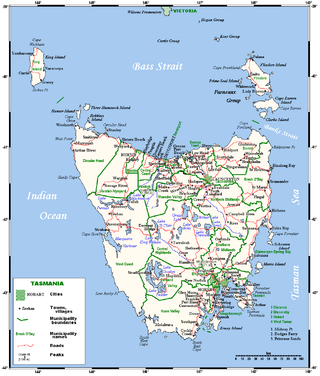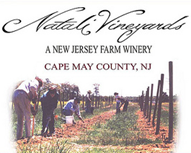
The Canberra District wine region is located around Canberra in the Capital city of Australia. It covers the northern part of the Australian Capital Territory and an area of New South Wales to the east and north of that, including towns of Bungendore, Murrumbateman and Yass, New South Wales.

The Pyrenees is a wine-producing region centred on the Pyrenees ranges located in Victoria, Australia near the town of Avoca.

The Walla Walla Valley AVA is an American Viticultural Area located within Washington state and extending partly into the northeastern corner of Oregon. The wine region is entirely included within the larger Columbia Valley AVA. In addition to grapes, the area produces sweet onions, wheat and strawberries. After the Yakima Valley AVA, the Walla Walla AVA has the second highest concentration of vineyards and wineries in Washington State. Walla Walla hosts about 140 wineries.

Tasmanian wine is wine produced in the Australian state of Tasmania. Located at a more southerly latitude than the rest of Australia's wine regions, Tasmania has a cooler climate and the potential to make distinctly different wines than in the rest of the country. The area grows primarily Pinot noir, Chardonnay and Sauvignon blanc, with some smaller plantings of Riesling, Pinot gris and Cabernet Sauvignon. Global warming has had positive effects on the Tasmanian wine industry, allowing most of the grapes in the past few vintages to ripen fully and produce more vibrant wine.

The South Australian wine industry is responsible for more than half the production of all Australian wine. South Australia has a vast diversity in geography and climate which allows the state to be able to produce a range of grape varieties–from the cool climate Riesling variety in the Clare Valley wine region to the big, full bodied Shiraz wines of the Barossa Valley.

Victorian wine is wine made in the Australian state of Victoria. With over 600 wineries, Victoria has more wine producers than any other Australian wine-producing state but ranks third in overall wine production due to the lack of a mass bulk wine-producing area like South Australia's Riverland and New South Wales's Riverina. Viticulture has existed in Victoria since the 19th century and experienced a high point in the 1890s when the region produced more than half of all wine produced in Australia. The phylloxera epidemic that soon followed took a hard toll on the Victoria wine industry which did not fully recover till the 1950s.

Friuli-Venezia Giulia wine is wine made in the northeastern Italian region of Friuli-Venezia Giulia. There are 11 denominazione di origine controllata (DOC) and 3 denominazione di origine controllata e garantita (DOCG) in the Friuli-Venezia Giulia area. The region has 3 indicazione geografica tipica (IGT) designations Alto Livenza, delle Venezie and Venezia Giulia. Nearly 62% of the wine produced in the region falls under a DOC designation. The area is known predominantly for its white wines, which are considered some of the best examples of Italian wine in that style. Along with the Veneto and Trentino-Alto Adige, the Friuli-Venezia Giulia forms the Tre Venezie wine region, which ranks with Tuscany and Piedmont as Italy's world class wine regions.
Valley View Winery is a winery in the Applegate Valley AVA in Southern Oregon, United States, founded in 1972.
Foris Vineyards Winery is an American winery located near Cave Junction, Oregon in the Illinois Valley region of the Rogue Valley AVA of Southern Oregon. As one of Oregon's pioneering grape growers, Ted Gerber planted his first vineyard in 1974. For 15 years, Gerber provided fruit to other winemakers, until 1986 when the winery was founded by Ted and Meri Gerber and the Foris label was launched.

British Columbia wine is Canadian wine produced in the province of British Columbia. Wines made from 100% British Columbia grapes can qualify for classification under one of British Columbia's two classification systems, depending on the variety, the winemaking techniques employed, and various other restrictions.

Reif Estate Winery is located in Niagara-on-the-Lake in Ontario, Canada. Reif Estate is primarily known for playing an important in role pioneering the Ontario wine Industry, as well as planting some of the first Vitis vinifera vines in the Niagara region.

An international variety is a grape variety that is widely planted in most of the major wine producing regions and has widespread appeal and consumer recognition. These are grapes that are highly likely to appear on wine labels as varietal wines and are often considered benchmarks for emerging wine industries. There is some criticism that the popularity of so-called international varieties comes at the price of a region's indigenous varieties. The majority of declared international varieties are French in origin, though in recent years the popularity of Spanish and Italian varietals has seen an increase in worldwide plantings and these may also be considered "international varieties".

The Lake Chelan AVA is an American Viticultural Area (AVA) in Washington State. Located in the north-central part of the state around Lake Chelan, the area is a sub-appellation of the greater Columbia Valley AVA. Of the 24,040 acres within the AVA's boundaries, only 260 acres were planted with wine grapes which was producing wine for fifteen wineries as of 2009. While viticulture has existed in the region since 1891, the area was approved as a federally designated wine region in April 2009 when it became Washington's 11th AVA.

Dutch wine is wine made in the Netherlands. Although a small producer of wine, it is nowadays a strong growing branch of Dutch agriculture. Currently, the country has 180 commercial vineyards.

Henschke is a family-owned, 155-year-old Australian winery, located in Keyneton, South Australia in the Eden Valley wine region. It produces the 'Hill of Grace', one of Australia's "cult wines", and was considered Australia's second best wine by James Halliday in 2009.
Cono Sur Vineyards & Winery is a subsidiary of Concha y Toro Winery and is the third largest exporter of bottled wine in Chile. Established in 1993, its name is a reference to its location in the Southern Cone of South America and a play on the word connoisseur. In 2015, it was the official wine of the Tour de France.

Natali Vineyards is a winery in the Goshen section of Middle Township in Cape May County, New Jersey, USA. Formerly a pasture for horses, the vineyard was first planted in 2001, and opened to the public in 2007. Natali has seven acres of grapes under cultivation, and produces 1,800 cases of wine per year. The winery is named after the vintner and co-owner of the winery.

Hawk Haven Vineyard & Winery is a winery in Rio Grande section of Lower Township in Cape May County, New Jersey. A family dairy and produce farm since 1940, the vineyard was first planted in 1997, beginning with Cabernet Sauvignon. The winery opened their doors to the public in 2009 with their first vintage in 2007, which consisted of the American Kestrel White, Red Table Wine, Merlot, and Cabernet Sauvignon. Today, Hawk Haven has 16 acres of grapes under cultivation, and produces 5,000 cases of wine per year. The winery is named for the large number of hawks that migrate to the farm every year. They currently have sixteen different varietals and all of the grapes are harvested, pressed, fermented, aged, blended, and bottled on site.
3 Riberas is a Spanish geographical indication for Vino de la Tierra wines located in the autonomous region of Navarre. Vino de la Tierra is one step below the mainstream Denominación de Origen indication on the Spanish wine quality ladder, and mirrors the Vins de pays of French wine. It acquired its Vino de la Tierra status in 2018.



















